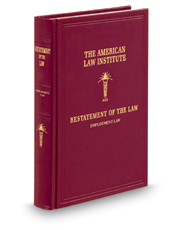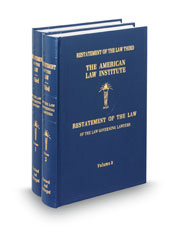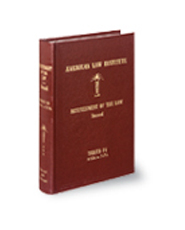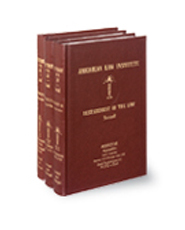About the Restatements of the Law
Definition & Topics Covered
Restatements of the Law are secondary resources that organize and summarize the common law into concise rules. They are written by scholars in various legal fields, and while they are secondary authority many judges consider them to be particularly persuasive secondary authority. Using them effectively summarizes common law issues throughout the United States of America.
Current restatement topics include Agency, Conflict of Laws, Contracts, Employment Law, Property, Restitution, Torts, and Trusts.
Special Persuasive Authority
As secondary resources, the Restatements of the Law are not Primary Law. However, in some jurisdictions the legislative or judicial branch gives such weight to the authority of a particular Restatement of the Law that the branch adopts that Restatement as the law for that jurisdiction or recognizes that Restatement as the best authority to guide judges in interpreting the law on certain legal issues.
Selected Finding Aids
Each restatement is handled separately, so has its own finding aids. The Index and Table of Contents are common to all.
- Index
- All restatements have at least one Index, and it is usually integrated into one or all of the print volumes. It is one of the first things you examine. It is an alphabetical list of every topic discussed in the restatement (or that particular volume of the restatement), and it shows you every section where each of those topics is discussed. The index may show you that your legal topic is actually discussed in multiple sections or chapters.
- Table of Contents
- All restatements have at least one Table of Contents, and it shows you where restatement's authors placed your legal topic in the organizational scheme of the restatement. The titles of sections near yours could indicate that those sections have relevant information on your topic. There is even more important information you can get from the Table of Contents. The placement of your section in the restatement in relation to the other sections and chapters gives you contextual information that you can use to develop your understanding of your legal topic. (E.G. Is your section listed under a heading like exceptions or exemptions to some general rule? If so, you need to find out about that general rule, and the Table of Contents is likely to show you another section where it's discussed.)
- Table of Cases
- If you know of a case relevant to your legal problem, then you can use the Table of Cases to find every section in the restatement that cites it as authority. The Table of Cases lists every case cited anywhere in the restatement. This allows you to see any other legal issues that could be related to a case relevant to your legal problem.
- Table of Statutes
- If you know of a statute relevant to your legal problem, then you can use the Table of Statutes to find every section in the restatement that cites it as authority. The Table of Statutes lists every statute cited anywhere in the restatement. This allows you to see any other legal issues that could be related to a statute relevant to your legal problem.
- Word Searches
- Last, least important, and often dangerous is the keyword search. Beware! (See entry under Legal Encyclopedias for the dangers of a keyword search.)
Structure a Typical Restatement Section
- Rule
- In bold face, just under the section title. This summarizes the common law on the legal topic by distilling it down to one concise rule statement (or it doesn't, but that's the idea). It may be that there is too much contradictory case law on the topic, and the rule must be from the majority of jurisdictions with a note to explain the minority law, or the rule may be from the minority of jurisdictions with a note explaining why the ALI is breaking from the majority of jurisdictions.
- Comments
- Comments explain the rule or an aspect of the rule.
- Illustrations
- Illustrations apply the rule, or an aspect of the rule explained in the immediately preceding comment, to a fact pattern.
- Reporters’ Note
- The Reporter’ Note shows the authority for the rule statement and may explain how certain comments and illustrations were derived from actual cases.
- Case Citations to the Restatement of Law (Pocket Part or Appendix Volumes)
- The ALI keeps track of cases that cite each section of a restatement. This can be useful to find cases with similar facts and legal issues to the one that you are researching.
Where Located
The restatements are in print on ground floor by the main doors, and they are available electronically with HeinOnline, Westlaw, and Lexis.
Selected Restatements
-
Restatement of the Law Third: Agency
Call Number: KF1345 .A764 2006 (1st Floor, Reference Collection)Covers the relationships between principal and agent, principal and third person, and agent and third person. States applicable rules when an agency relationship exists, and deals with situations similar to an agency relationship. Restatements of the Law on Agency are also available on Westlaw. -
Restatement of the Law Second: Conflict of Laws
Call Number: KF411 .A43 1971 (1st Floor, Reference Collection)Explains and analyzes legal situations with connections to two or more jurisdictions. Contains the black-letter statements, comments, illustrations, and reporter's notes. Restatements of the Law on Conflict of Laws are also available on Westlaw. -
Restatement of the Law Second: Contracts
Call Number: KF801.A2 A46 (1st Floor, Reference Collection)Restatement of the Law of Contracts is also available on Westlaw. -
 Restatement of the Law: Employment Law
Federal and State statutes as well as precedent from state appellate courts govern the employment relationship, and the law continues to change. Subjects covered in this restatement unit include the employment relationship, termination of employment contracts, compensation and benefits, employer liability for harm to employees, wrongful discharge, employee privacy and autonomy, employee obligations, restrictive covenants, and remedies. The Restatement of the Law on Employment Law is also available on Westlaw.
Restatement of the Law: Employment Law
Federal and State statutes as well as precedent from state appellate courts govern the employment relationship, and the law continues to change. Subjects covered in this restatement unit include the employment relationship, termination of employment contracts, compensation and benefits, employer liability for harm to employees, wrongful discharge, employee privacy and autonomy, employee obligations, restrictive covenants, and remedies. The Restatement of the Law on Employment Law is also available on Westlaw. -
 Restatement of the Law Third: the Foreign Relations Law of the United States
Call Number: KF 4651 .A73 1987 (1st Floor, Reference Collection)International law as it applies to the United States and domestic law impacting foreign relations. Discusses the sources of international law and its place in U.S. jurisprudence. Restatements of the Law on Foreign Relations Law of the United States are also available on Westlaw.
Restatement of the Law Third: the Foreign Relations Law of the United States
Call Number: KF 4651 .A73 1987 (1st Floor, Reference Collection)International law as it applies to the United States and domestic law impacting foreign relations. Discusses the sources of international law and its place in U.S. jurisprudence. Restatements of the Law on Foreign Relations Law of the United States are also available on Westlaw. -
Restatement of the Law Second: Judgments
Call Number: KF 8990 .A965 (1st Floor, Reference Collection)The preclusive effects of judgments in civil actions and the extent to which the law governing whether an adjudicated issue may be relitigated depends on the procedural opportunities that had been available to litigate it fully and fairly the first time. Restatements of the Law on Judgments are also available on Westlaw. -
 Restatement of the Law Third: The Law Governing Lawyers
Call Number: KF 308 .R48 2000 (1st Floor, Reference Collection)Explanation and analysis of United States law concerning lawyers. Offers guidance on the laws governing law practice. Coverage includes tort doctrine relating to, Malpractice, Vicarious liability, Work product doctrine, Attorney-client privilege, Agent-principal relationship, and other Related areas. Provides general rules clearly stated, as well as possible limitations on the application of a rule. The Restatement of the Law on the Law Governing Lawyers is also available on Westlaw.
Restatement of the Law Third: The Law Governing Lawyers
Call Number: KF 308 .R48 2000 (1st Floor, Reference Collection)Explanation and analysis of United States law concerning lawyers. Offers guidance on the laws governing law practice. Coverage includes tort doctrine relating to, Malpractice, Vicarious liability, Work product doctrine, Attorney-client privilege, Agent-principal relationship, and other Related areas. Provides general rules clearly stated, as well as possible limitations on the application of a rule. The Restatement of the Law on the Law Governing Lawyers is also available on Westlaw. -
 Restatement of the Law Third: Property—Wills and Other Donative Transfers
Call Number: KF 613 .R47 1999 (1st Floor, Reference Collection)Covers donative transfers, which require coverage of other legal fields including federal and state tax, corporate, partnership, contract, agency, and domestic relations law. Coverage also includes will substitutes, intestacy, gifts, present and future interests, and construction of donative documents. Restatements of the Law on Property are also available on Westlaw.
Restatement of the Law Third: Property—Wills and Other Donative Transfers
Call Number: KF 613 .R47 1999 (1st Floor, Reference Collection)Covers donative transfers, which require coverage of other legal fields including federal and state tax, corporate, partnership, contract, agency, and domestic relations law. Coverage also includes will substitutes, intestacy, gifts, present and future interests, and construction of donative documents. Restatements of the Law on Property are also available on Westlaw. -
 Restatement of the Law Third: Restitution and Unjust Enrichment
Call Number: KF 1244.Z95 R48 2011 (1st Floor, Reference Collection)Restatements of the law on Restitution and Unjust Enrichment are also available on Westlaw.
Restatement of the Law Third: Restitution and Unjust Enrichment
Call Number: KF 1244.Z95 R48 2011 (1st Floor, Reference Collection)Restatements of the law on Restitution and Unjust Enrichment are also available on Westlaw. -
 Restatement of the Law Third: Suretyship and Guaranty
Call Number: KF 1045 .A938 1996 (1st Floor, Reference Collection)This text focuses on application of suretyship law (concerning the assumption by one party of the liability for a debt of another) in the fields of both "traditional suretyship," including most prominently payment and performance bonds in construction contracts, and commercial law, notably financial institutions primarily involving extension of credit. Restatements of the law on Security, Suretyship and Guaranty are also available of Westlaw.
Restatement of the Law Third: Suretyship and Guaranty
Call Number: KF 1045 .A938 1996 (1st Floor, Reference Collection)This text focuses on application of suretyship law (concerning the assumption by one party of the liability for a debt of another) in the fields of both "traditional suretyship," including most prominently payment and performance bonds in construction contracts, and commercial law, notably financial institutions primarily involving extension of credit. Restatements of the law on Security, Suretyship and Guaranty are also available of Westlaw. -
 Restatement of the Law Third: Torts, Apportionment of Liability
Call Number: KF 1249.A4 R47 2000 (1st Floor, Reference Collection)American common law of torts concerning apportionment of liability. Addresses basic elements of the tort action for liability accruing including accidental personal injury, property damage, liability for physical and emotional harm, and products liability. Restatements of the Law on Torts are also available on Westlaw.
Restatement of the Law Third: Torts, Apportionment of Liability
Call Number: KF 1249.A4 R47 2000 (1st Floor, Reference Collection)American common law of torts concerning apportionment of liability. Addresses basic elements of the tort action for liability accruing including accidental personal injury, property damage, liability for physical and emotional harm, and products liability. Restatements of the Law on Torts are also available on Westlaw. -
 Restatement of the Law Third: Torts, Liability for Physical and Emotional Harm
Call Number: KF 1257 .R47 2010 (1st Floor, Reference Collection)Covers the basic elements of the tort action for liability for accidental personal injury and property damage and for liability for emotional harm. Restatements of the Law on Torts are also available on Westlaw.
Restatement of the Law Third: Torts, Liability for Physical and Emotional Harm
Call Number: KF 1257 .R47 2010 (1st Floor, Reference Collection)Covers the basic elements of the tort action for liability for accidental personal injury and property damage and for liability for emotional harm. Restatements of the Law on Torts are also available on Westlaw. -
 Restatement of the Law Third: Torts, Products liability
Call Number: KF 1296 .R491 1998 (1st Floor, Reference Collection)The common law of torts concerning products liability. Restatements of the Law on Torts are also available on Westlaw.
Restatement of the Law Third: Torts, Products liability
Call Number: KF 1296 .R491 1998 (1st Floor, Reference Collection)The common law of torts concerning products liability. Restatements of the Law on Torts are also available on Westlaw. -
 Restatement of the Law Third: Trusts
Call Number: KF 730 .R47 2003 (1st Floor, Reference Collection)Organizes and explains the principles in the field of trusts. Identifies particular social goals, such as implementing a settlor's purposes, and applies society's limits to those purposes. Restatements of the law on Trusts are also available of Westlaw.
Restatement of the Law Third: Trusts
Call Number: KF 730 .R47 2003 (1st Floor, Reference Collection)Organizes and explains the principles in the field of trusts. Identifies particular social goals, such as implementing a settlor's purposes, and applies society's limits to those purposes. Restatements of the law on Trusts are also available of Westlaw.
